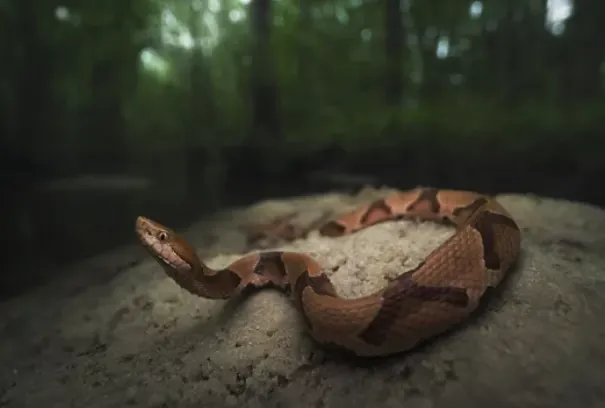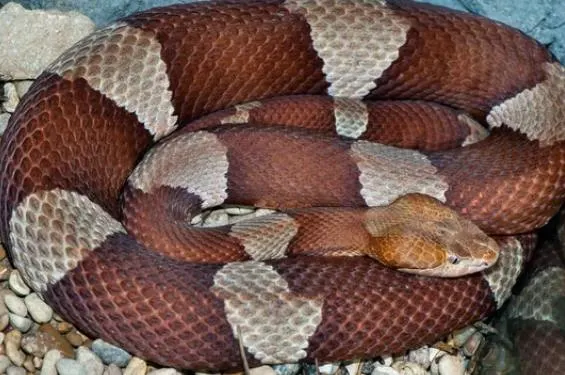Copperhead snakes, scientifically known as Agkistrodon contortrix, are among the most recognized and widespread venomous snakes in the United States. With their distinctive copper-colored heads, these snakes are fascinating creatures that play a vital role in the ecosystems they inhabit. Despite their fearsome reputation, copperheads are generally non-aggressive and prefer to avoid human interaction. Let’s delve into some intriguing facts about this remarkable species.

Table of Contents
1. Physical Characteristics and Identification
Copperheads are medium-sized snakes, typically ranging from 2 to 4 feet in length, though some individuals may grow slightly larger. Their most striking feature is the coppery hue of their heads, which gives them their common name. The body of a copperhead is adorned with hourglass-shaped bands of dark brown or reddish-brown across a lighter tan or pinkish background. These patterns provide excellent camouflage, allowing them to blend seamlessly into the forest floor, making them nearly invisible to both predators and prey.
The snake’s head is broad and wedge-shaped, with a distinct neck that sets it apart from its body. Their scales are keeled, giving them a rough texture, and their eyes have vertical, cat-like pupils, which are typical of many nocturnal hunters. The eyes of a copperhead can range in color from tan to orange, adding to their striking appearance. Juvenile copperheads are similar in appearance to adults but are usually more grayish, with bright yellow or greenish-yellow tips on their tails, which they use as a lure to attract prey.
2. Habitat and Distribution
Copperheads are highly adaptable and can be found across a wide range of habitats in the eastern and central United States. Their range extends from southern New England through the Southeast, across the Midwest, and into parts of Texas and northern Mexico. They thrive in deciduous forests, rocky hillsides, wetlands, and areas near streams or rivers. Copperheads are also commonly found in suburban and rural areas, where they may encounter humans more frequently.
One of the reasons for their wide distribution is their ability to tolerate a variety of environmental conditions. Copperheads can be found at elevations from sea level to mountainous regions, and they are equally at home in dry, rocky terrain as they are in moist, wooded areas. During the cooler months, they seek out hibernation sites in rock crevices, hollow logs, or even human-made structures like basements and crawlspaces.
3. Diet and Hunting Behavior
Copperheads are carnivorous, with a diet that varies depending on their age and size. They primarily feed on small mammals such as mice, voles, and shrews, but they are also known to eat birds, amphibians, insects, and other small snakes. Juvenile copperheads often prey on smaller creatures like frogs and lizards, using their brightly colored tail tips to lure them within striking distance.
As pit vipers, copperheads possess heat-sensing pits located between their eyes and nostrils. These pits allow them to detect the body heat of warm-blooded prey, even in complete darkness. Copperheads are ambush predators, lying in wait for their prey to come close before striking quickly and injecting venom. Their venom is a hemotoxin, which breaks down blood cells and tissues, aiding in the digestion of their prey. Despite their venomous bite, copperheads typically avoid confrontation with humans and will only strike if they feel threatened or are accidentally stepped on.
4. Reproduction and Lifespan
Copperheads have an interesting reproductive cycle, with mating occurring twice a year: once in the spring and again in the late summer to early fall. Males engage in combat for the attention of females, often wrestling in a display of strength. Once a male successfully courts a female, she may store sperm for several months before fertilization occurs, allowing her to time the birth of her offspring with favorable environmental conditions.
Copperheads give birth to live young, rather than laying eggs. A single litter can range from 1 to 21 neonates, though the average is about six to eight. The newborns are fully equipped with functional fangs and venom, and while they are independent from birth, they may stay near their mother for a few days before venturing out on their own.
The lifespan of a copperhead in the wild can range from 15 to 29 years, depending on factors such as predation, availability of
5. Venom and Human Interaction
Copperhead venom is not the most potent among venomous snakes, but it is still capable of causing significant pain and injury. The venom primarily affects the circulatory system, breaking down blood cells and causing localized tissue damage. Symptoms of a copperhead bite include severe pain, swelling, nausea, and in some cases, muscle and bone damage if the bite is severe. However, copperhead bites are rarely fatal to humans, and the snakes often deliver “dry bites” without venom as a warning.
Despite their venomous nature, copperheads are generally shy and non-aggressive. They prefer to remain motionless when approached, relying on their camouflage to avoid detection. If they feel threatened, they may vibrate their tails as a warning, a behavior that mimics the sound of a rattlesnake. This tactic, combined with their coloration, often deters potential predators.
For humans, the best way to avoid a copperhead bite is to be aware of your surroundings when in their habitat. Wearing protective footwear and being cautious when moving through areas with dense leaf litter or rocks can reduce the risk of accidentally stepping on one.

6. Ecological Importance
Copperheads play a crucial role in controlling the populations of small mammals and other prey species, helping to maintain a balanced ecosystem. Their predation on rodents, in particular, can benefit agricultural areas by reducing the number of pests that damage crops. Additionally, copperheads serve as prey for larger predators such as hawks, owls, and other snakes, contributing to the overall
In recent years, copperheads have also gained attention for their potential medical applications. Researchers have studied components of copperhead venom for use in developing new medications, particularly in the treatment of blood clots and certain cancers. This highlights the importance of preserving these snakes and their habitats, as they may hold the key to future medical advancements.
The copperhead snake is a fascinating and often misunderstood reptile. While it is true that they are responsible for more snakebites in the United States than any other venomous snake, these bites are rarely life-threatening. Copperheads prefer to avoid confrontation and will only bite in self-defense. By understanding and respecting these remarkable creatures, we can coexist with them peacefully and appreciate the vital role they play in our natural world.
- Enchi Ball Python: A Unique and Stunning Morph of Python regius - March 27, 2025
- Emerald Tree Monitor: The Enigmatic Green Guardian of the Rainforest - March 26, 2025
- The Egyptian Cobra (Naja haje): A Fascinating Serpent - March 25, 2025
